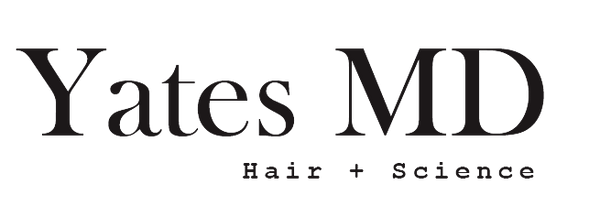Get hair, health, and science news delivered right to your inbox.
Are you familiar with Minoxidil? It's a popular ingredient found in many hair products, lauded for its ability to support hair growth and thickness. But like any potent substance, it comes with its own set of side effects.
If you're considering using minoxidil, and concerned about potential side effects, this is your essential guide to understanding minoxidil side effects and how to manage them.
What is Minoxidil?
Minoxidil is an over-the-counter medication often used to slow down hair loss and promote hair regrowth. It's available in two forms: a topical solution that you apply directly to your scalp and an oral tablet. However, the oral form is primarily used to treat high blood pressure and isn't typically prescribed for hair loss.
The exact way minoxidil works isn't entirely understood. It's believed to prolong the growth phase of the hair follicles, leading to longer and potentially thicker hair.
The Science Behind Minoxidil and Hair Growth
While the precise process through which minoxidil fosters hair growth continues to be researched, it's theorized to function in two main manners.
Initially, it aids in expanding the blood vessels, enhancing the performance of hair follicles and triggering hair growth. Subsequently, it extends the anagen phase (active growth phase) of hair growth, leading to lengthier and possibly denser strands.
It's also worth noting that minoxidil does not work for everyone. The effectiveness of minoxidil varies from person to person. Factors such as the extent and type of hair loss, age, and how early treatment is started can all influence how well minoxidil works for you.
Common Minoxidil Side Effects
While minoxidil's efficacy in promoting hair growth is well-known, it's also crucial to understand its minor side effects. These are typically nothing to fear, but here are a few of the most commonly observed ones:
- Skin irritation: This can include redness, dryness, scaling, and even itchiness at the application site.
- Hair growth in undesired areas: There can be instances where minoxidil inadvertently triggers hair growth in areas it was not intended for, if the medication inadvertently comes into contact with those regions.
- Weight gain: Some users have reported unexplained weight gain after using minoxidil.
Remember, everyone's body reacts differently to medications. You might experience none, some, or all of these side effects. The key is to monitor your reactions closely and seek medical advice if you're concerned.
How To Manage Minoxidil Side Effects
Now that we've covered the common side effects, let's dive into how to manage them. Here are some practical tips:
- If you're experiencing dryness or itchiness, try applying a moisturizer or hydrocortisone cream to the affected area. However, always wait until the minoxidil has fully dried before applying any other products to avoid diluting its effectiveness.
- To prevent unwanted hair growth, make sure to apply minoxidil only to the scalp or areas where you want hair to grow. Wash your hands thoroughly after application.
- While it's not clear why minoxidil might cause weight gain, maintaining a balanced diet and regular exercise can help manage your weight.
Bear in mind that although these suggestions can aid in controlling side effects, it's essential to always seek advice from a healthcare professional prior to initiating or discontinuing any medication.
Is Minoxidil Right for You?
Deciding to use minoxidil is a personal decision that should be made after careful consideration and consultation with a healthcare provider. While minoxidil can help slow hair loss and promote hair regrowth, it's not a cure for baldness. Once you stop using minoxidil, any regrown hair may disappear, and the rate of hair loss can revert to what it was before.
Remember, managing minoxidil side effects is crucial to ensuring a positive experience with this medication. If you decide to use minoxidil, start with a lower strength to see how your body reacts, and then gradually increase the strength under the guidance of a healthcare provider.
Alternatives to Minoxidil
If you're unable or unwilling to use minoxidil, or if you've tried it and didn't get the results you were hoping for, don't despair. There are other options available. For instance, certain lifestyle changes such as a balanced diet, regular exercise, and avoiding heat or chemical-based hair treatments can help promote healthier hair.
In addition, there are other treatments available that combine natural and scientific ingredients to support hair growth without the side effects associated with minoxidil. For more information on such products, visit Yates MD.
Natural Methods to Complement Minoxidil Use
Even if you choose to use minoxidil, incorporating natural methods into your hair care routine can enhance its effectiveness. Here are some proven strategies:
- Nutritious Eating Habits: Consuming foods abundant in vitamins A, C, D, E, along with proteins and omega fatty acids, can contribute to the health and vitality of your hair.
- Consistent Physical Activity: Engaging in regular exercise can boost circulation to the scalp, providing nourishment to the hair follicles, and thereby encouraging hair growth.
- Daily Scalp Massage: A few minutes of daily scalp massage can enhance blood flow to your hair follicles, fostering an environment conducive to hair growth.
- Maintaining Hydration: Ensuring adequate hydration is vital for your overall well-being, including the health of your hair. Water plays a key role in hydrating hair from within, fostering growth, and enhancing its luster.
- Managing Stress: Persistent stress can lead to hair loss. Practices like meditation, yoga, or other relaxation exercises can assist in regulating stress levels, thus contributing to healthier hair.
- Quality Rest: Sound sleep is essential for a healthy body, including the growth of hair. As you sleep, your body undergoes repair and regeneration processes, which can be beneficial for your hair follicles.
- Minimizing Heat and Chemical Exposure: Excessive use of heat styling devices and harsh chemical treatments can inflict damage on your hair and impede its growth. Aim to restrict their usage and choose natural styling techniques wherever feasible.
- Utilizing Essential Oils: Certain essential oils, such as rosemary, lavender, and peppermint, have demonstrated potential in promoting hair growth. Always remember to dilute essential oils prior to applying them to your scalp.
These methods don't replace minoxidil but can complement its use, providing a more comprehensive approach to hair loss management. Always consult with a healthcare provider before starting any new hair care regimen.
Safety Precautions When Using Minoxidil
While minoxidil is generally safe for most people, there are several precautions you should take:
- Never use more than what's recommended, as this can increase the risk of side effects.
- It's vital that you follow the dosage guidelines given on the product's packaging or as recommended by your medical practitioner.
- If you are expecting, contemplating pregnancy, or breastfeeding, it's of utmost importance to consult with your healthcare professional before usage.
- Refrain from applying minoxidil on skin that is irritated, sunburned, or damaged, as this could result in enhanced absorption into the body and increase the likelihood of experiencing side effects.
- If your hair loss continues or worsens after using minoxidil, seek medical advice.
Minoxidil has the potential to be a successful remedy for hair loss, but it's imperative to stick to the prescribed dosage, engage in discussions with your healthcare provider prior to its use, and seek professional medical counsel if your hair loss persists or intensifies.
Final Thoughts on Minoxidil Side Effects and How to Manage Them
Minoxidil can be a game-changer for those struggling with hair loss, but it's essential to be aware of its potential side effects. By understanding these side effects and how to manage them, you can make an informed decision about whether this treatment is right for you.
If you're looking for an alternative solution or a product to use in conjunction with minoxidil, consider exploring Yates MD. We offer a range of hair loss products that combine natural and scientific ingredients, providing a comprehensive approach to hair loss management.


